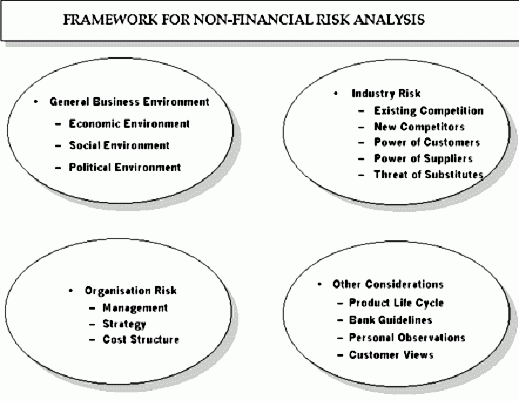A Framework for Analysing Customer Credit Risk
Category: Financial Risk Management
We are going to finish this module with a Case Study in which we will try to examine most of the non-financial and financial factors affecting an individual business and how we may come to a considered opinion on the level of risk involved for a bank lending to that business.
Firstly, let us put together the main points considered in this Module and in the previous Module in the series (Module 2) to provide us with a framework for analysing customer credit risk.
Framework for Non Financial Risk Analysis
Non Financial Risk Analysis is the main topic considered in Module 2 of this series. Slide 31 shows a large number of headings that need to be considered by the credit analyst. Any one of these can have a major impact on the future of a business and, hence, on its ability to generate sufficient profits and cash flow to repay bank borrowings. For instance, if the management of a business is poor, almost inevitably its prospects are poor, no matter what other factors are in its favour.
If a credit analyst or relationship manager considers a business under all of these headings he/she will have built up a good knowledge of the business and what may happen to the business over the near future. Of course, the longer the time frame, the greater the uncertainty and, therefore, the greater the credit risk.
Framework for Analysis of Customer Financial Statements
Next shows a framework we might use for analysing the most up-to-date financial information available from the customer. Of course we must always bear in mind the figures themselves are meaningless without reference to trends, industry norms etc.
Analysis of customer financial statements:
-Activity
Sales Growth
— Profitability
Gross Profit Margin
Operating Profit Margin
Net Profit Margin
— Liquidity
Current Ratio
Quick Asset Ratio
— Working Capital Ratios
Debtor Collection Days
Stock Turnover Days
Credit Payment Period
— Gearing
Total Gearing
Bank Gearing
Repayment Capacity
Having considered all of these factors, both financial and non financial, we should be in a good position to make some reasonable assumptions about the immediate future of the business. These assumptions should underlie our calculation of repayment capacity for existing and proposed loans in the manner we looked at near the end of Session 2.
Other Factors
Finally, if we consider there is repayment capacity without unacceptable risk attaching to it, we must consider the other risk factors e.g.
What constitutes acceptable Security, to limit our risk further?
Looking at the proposition in the context of our existing portfolio, does it constitute acceptable risk?
What terms and conditions should apply?
How will we structure debt?

